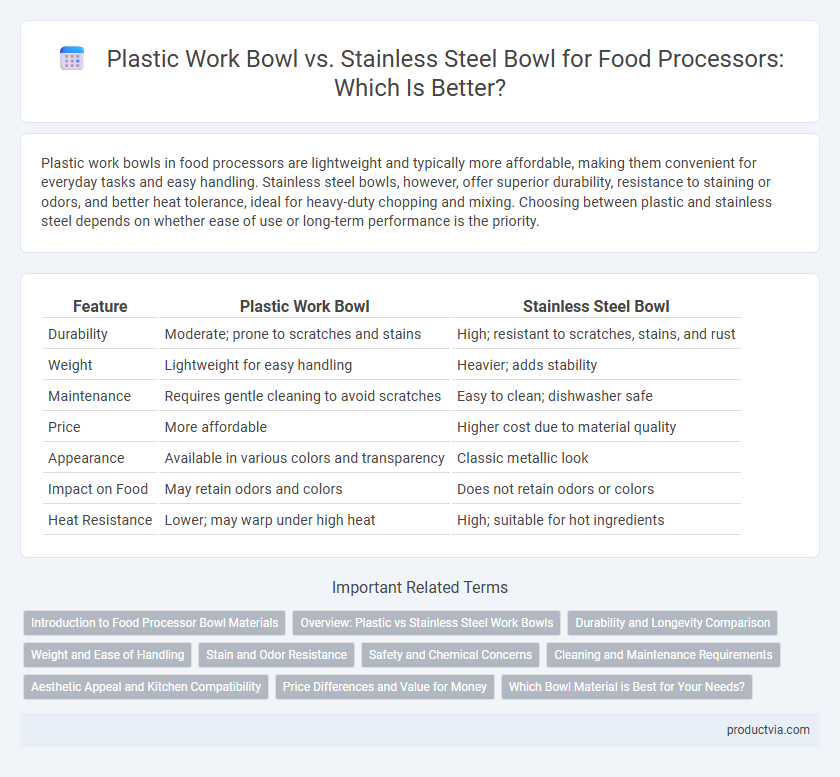Plastic work bowls in food processors are lightweight and typically more affordable, making them convenient for everyday tasks and easy handling. Stainless steel bowls, however, offer superior durability, resistance to staining or odors, and better heat tolerance, ideal for heavy-duty chopping and mixing. Choosing between plastic and stainless steel depends on whether ease of use or long-term performance is the priority.
Table of Comparison
| Feature | Plastic Work Bowl | Stainless Steel Bowl |
|---|---|---|
| Durability | Moderate; prone to scratches and stains | High; resistant to scratches, stains, and rust |
| Weight | Lightweight for easy handling | Heavier; adds stability |
| Maintenance | Requires gentle cleaning to avoid scratches | Easy to clean; dishwasher safe |
| Price | More affordable | Higher cost due to material quality |
| Appearance | Available in various colors and transparency | Classic metallic look |
| Impact on Food | May retain odors and colors | Does not retain odors or colors |
| Heat Resistance | Lower; may warp under high heat | High; suitable for hot ingredients |
Introduction to Food Processor Bowl Materials
Food processor bowls are commonly made from either plastic or stainless steel, each offering distinct advantages in durability and weight. Plastic bowls are lightweight and transparent, allowing users to monitor food processing progress easily, while stainless steel bowls provide superior strength, resistance to stains, and enhanced longevity. Choosing between plastic and stainless steel depends on factors such as usage frequency, maintenance preferences, and desired aesthetic appeal.
Overview: Plastic vs Stainless Steel Work Bowls
Plastic work bowls for food processors offer lightweight convenience and typically come with measurement markings for easy ingredient tracking, making them ideal for everyday kitchen use. Stainless steel bowls provide superior durability, increased resistance to stains and odors, and a sleek, professional look, which is preferred for heavy-duty food processing tasks. Choosing between plastic and stainless steel depends on factors such as budget, frequency of use, and the type of food preparation involved.
Durability and Longevity Comparison
Stainless steel bowls for food processors offer superior durability and resist dents, scratches, and stains better than plastic work bowls. Plastic bowls, while lighter and often less expensive, are prone to cracking, discoloration, and wear over time, reducing their longevity. Choosing a stainless steel bowl enhances the food processor's lifespan, providing consistent performance even with frequent heavy-duty use.
Weight and Ease of Handling
Plastic work bowls for food processors are lighter and easier to handle compared to stainless steel bowls, making them ideal for quick and convenient food preparation. Stainless steel bowls, while more durable and resistant to staining, tend to be heavier, which may affect ease of lifting and maneuverability during use. Choosing between plastic and stainless steel depends on prioritizing lightweight convenience or robust construction for long-term durability.
Stain and Odor Resistance
Stainless steel bowls for food processors offer superior stain and odor resistance compared to plastic work bowls, preventing discoloration and lingering smells from strong ingredients like garlic and turmeric. The non-porous surface of stainless steel inhibits absorption of food particles and odors, ensuring easier cleaning and longer-lasting freshness. Plastic bowls tend to retain stains and odors over time due to their porous nature, which can impact the taste and hygiene of future food preparations.
Safety and Chemical Concerns
Plastic work bowls in food processors may pose safety risks due to potential leaching of harmful chemicals like BPA or phthalates, especially when exposed to heat or acidic ingredients. Stainless steel bowls offer superior chemical resistance, preventing contamination and ensuring food safety without absorbing odors or stains. Choosing stainless steel reduces concerns about plastic degradation and promotes a safer, more hygienic food preparation environment.
Cleaning and Maintenance Requirements
Plastic work bowls in food processors are lightweight and dishwasher-safe but tend to retain stains and odors, requiring more frequent deep cleaning with baking soda or vinegar solutions. Stainless steel bowls resist staining and odors, making them easier to clean with just soap and water, and they typically withstand higher dishwasher temperatures without damage. While stainless steel demands less maintenance, plastic bowls require careful handling to avoid scratches that can harbor bacteria over time.
Aesthetic Appeal and Kitchen Compatibility
Plastic work bowls for food processors offer a lightweight and translucent design that blends seamlessly into modern kitchens, enhancing aesthetic appeal with their sleek, minimalist look. Stainless steel bowls provide a polished, professional finish that complements stainless steel appliances, adding a durable and timeless element to kitchen decor. Choosing between the two depends on whether a kitchen prioritizes contemporary versatility with plastic or classic elegance with stainless steel.
Price Differences and Value for Money
Plastic work bowls for food processors typically cost less, making them an economical choice for budget-conscious users. Stainless steel bowls, while priced higher, offer superior durability and resistance to stains and odors, providing better long-term value. Investing in a stainless steel bowl can reduce replacement frequency, enhancing overall cost-effectiveness despite the initial higher price.
Which Bowl Material is Best for Your Needs?
Plastic work bowls for food processors offer lightweight convenience and often include measurement markings for easy ingredient tracking, making them ideal for everyday tasks and short processing sessions. Stainless steel bowls excel in durability, resistance to stains and odors, and superior temperature tolerance, making them perfect for heavy-duty use and processing hot ingredients. Choosing the best bowl material depends on your cooking frequency, type of food preparation, and preference for durability versus weight.
Plastic work bowl vs Stainless steel bowl for Food processor Infographic

 productvia.com
productvia.com